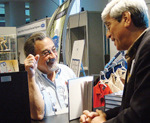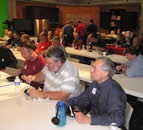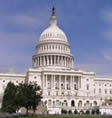Certified Radio Operator (CRO) and
Certified Television Operator (CTO)
Because Certified Radio Operator and Certified Television Operator are operator certifications (rather than engineering certifications), they are administered in a unique way, through the study of a certification handbook and completion of a test based on that material.
SBE Certification is not an FCC requirement. Nevertheless, it is evidence of an individual’s qualifications to serve as an operator at a broadcast station and will certainly be useful when seeking employment or advancement. Each radio and television station has its own policies and procedures, and many have a written station manual. However, the FCC Rules and basic operator procedures apply to all stations. The Certification Handbook for Radio Operators and the Television Operator’s Certification Handbook fill the needs of broadcast stations and operators today.
The SBE Radio and Television Operator Certifications are a great way to demonstrate to a prospective employer that you have acquired the basic knowledge to operate a radio or television station and comply with FCC Rules and Regulations. SBE member engineers are encouraged to help promising newcomers by giving advice and directions.
Certification Handbook for Radio Operators, 3rd Ed.
In the early 1980’s, and as part of their deregulation process, the Federal Communications Commission (FCC) abolished the mandatory requirement for Radio Station Operators and Engineers to hold an FCC license of any class. That left the industry without a tool for measuring a perspective employee’s proficiency in station operations. Since that time the Society of Broadcast Engineer’s certification program has become the industry’s benchmark standard for gauging an individual’s knowledge, skills, and abilities required for the operation of a broadcast station. This handbook helps operators learn more about the technical and business facets of a radio station. Its broad-scope contents are extremely helpful to seasoned professionals as well as anyone who is new to the radio station business.
The book covers the general responsibilities of a radio operator including professional etiquette, management structure, station operations, FCC rules, and a typical radio station technical layout. Topics include various types of microphones and their use, digital audio mixing devices, audio processors, equalizers, electronic audio routing, computerized recording and playback systems, program-audio delay equipment, telephone-interface equipment, studio to transmitter (STL) links, transmitter remote control and monitoring methods, and satellite program delivery systems. The book refers to many of the digital technologies used in broadcasting. Other chapters cover station logs, the Emergency Alert System (EAS), safety requirements, meter reading procedures, and station identification requirements and procedures. A comprehensive glossary is included as a quick reference guide.
A thorough study of this book will prepare the reader for the SBE Radio Operator certification test. Successful completion of the test assures any perspective radio station employer of your knowledge and skills required to become a Radio Station Operator.
Television Operator’s Certification Handbook, 7th Ed.
The SBE National Certification Committee, in cooperation with the Ennes Educational Foundation Trust, developed the Television Operator Certification along with this handbook to target the entry-level, non-technical pool of applicants that fill master control positions in today’s television marketplace. It also provides a good first step for those interested in pursuing a technical career in broadcast engineering.
There was once a requirement that television operators hold a First Class FCC license. This provided employers with an indication that the applicant had demonstrated enough technical knowledge to pass elements one through four of a federal government exam. In 1994, SBE developed the Television Operator Certification to assist employers in evaluating applicants. Many stations now make certification a requirement for employment for their operators.
The new 7th edition has been totally rewritten and updated to include the latest developments in digital television. It is designed for the entry level, non-technical pool of applicants that fill master control positions in todayís television marketplace.
The 7th edition includes practical information on the Emergency Alert System, FAA tower lighting, remote control operation, FCC power levels, program sources, ingesting, Childrenís Television time restrictions and more. It contains new and updated information on how TV facilities work, operating the station, the duties of master control operators and maintaining the station logs. It explains the digital signal path as programming passes through typical equipment found in a modern digital master control. The last chapter provides a basic introduction to the principles of 8-VSB transmission, video compression, PSIP and the DTV formats used to display the video picture on the home receiver.
This handbook assumes a basic familiarity with television station equipment and operations and provides most of the general information necessary for television operators. Readers may be working operators wishing to certify their skills and knowledge. Others may wish to become a television operator as their entry into the world of broadcasting. Your interest may lie in the creative side of television production, and the position of master control operator can open the door to that goal. There is a sample test at the end of the handbook that closely reflects the material covered in the actual test.
CRO/CTO Testing Procedures
You may order the operator handbooks from the SBE Bookstore. Once you have completed studying a handbook, you may fill in the application for certification included in the back of the handbook. You have one year from the purchase date of the handbook to take the exam, and your deadline will be clearly stamped on the application. These exams are given by a special designated proctor or a local SBE chapter. Membership in the SBE is not required for operator certification. The cost of certification testing is included in the price of the handbook.
The Certified Radio or Television Operator Exam: Exams consist of 50 multiple-choice questions based entirely on the material in the handbooks. The exam is closed book and one hour is allotted. Each exam is computer-selected from a pool of questions, and every exam is unique. The exam questions cover essentially the same material as the questions in the sample exam found in the back of each handbook. Passing score for the exam is 90%.









